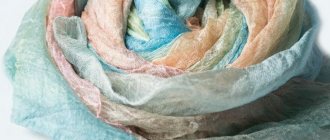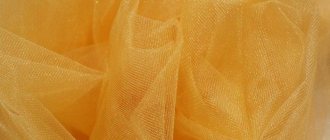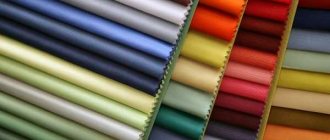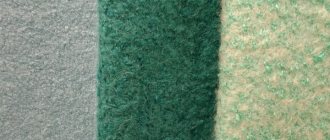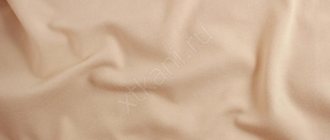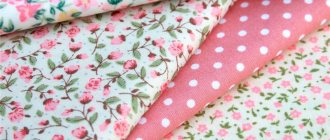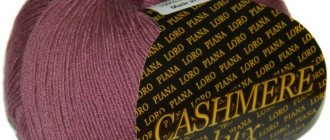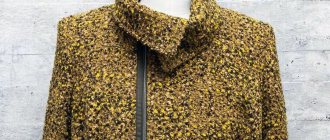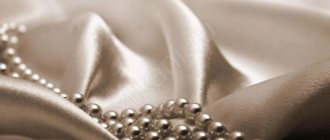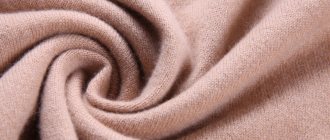Translated from English, interlock means “crossing.” This material is 100% cotton but has a nice smooth finish on both sides. Its density is 240-330 g/m2.
Interlock is classified as double knitwear, since two rows of knitting machine needles are used in the manufacture of the fabric. During the weaving process, the erasers intersect imperceptibly within the fabric, resulting in a double-sided fabric that has no face and no back. Hence the second name - dvulastic.
Since such knitwear is very soft and pleasant to the body, children's clothing, pajamas, dressing gowns and much more are made from it. If you change the knitting mode, you can get a fleecy material, and two colors of thread when knitting give a checkered or striped pattern. Often a printed design is applied to clothing.
Description of interlock
Interlock - what kind of fabric? It is a cotton knitted fabric. It has a dense structure and does not stretch well. This is achieved through a special double-sided weave. It is also called dvulastic. The fabric is equally smooth on both sides. The fabric has no outside or back side. However, with special processing, vertical stripes can be achieved.
Interlock is divided into three types depending on quality. What kind of fabric is this?
- Penye cotton (high quality), the fabric is made from long-fiber raw materials, it has an exceptionally smooth surface;
- Ring or card (this is good quality), medium-length fibers are used in production;
- Oppenend (low quality), made from short-staple cotton raw materials.
The presentation of the fabric and the finished product depends on the grinding of the thread and the raw materials used to form the fabric. Of course, based on this, the final price is determined. Despite the fact that manufacturers usually indicate the high quality of interlock, you can verify the correctness of this characteristic by simply carefully examining the fabric itself. The higher the quality, the fewer fibers and irregularities there will be on the surface of the fabric.
Origin story
This material was produced by the ancient Egyptians. Time passed, technological progress did not stand still, and the dvullastik began to slowly spread in Europe. Back then, the material was made by hand, so the process was long and energy-consuming. Knitting machines have helped improve quality significantly.
In addition, it became possible to create thin canvases. The upper class of society became interested in the canvas. Interlock gradually came into use among the rich: stockings and underwear made from this material are soft and comfortable.
Manufacturing
Read about: crepe de Chine fabric: when femininity is in fashion.
According to the knitting method, interlock refers to double knitwear. The fabric is made by weaving threads. They continuously bend into loops, connecting with each other. The loop is the basis of knitting. Its main elements are the broach and the skeleton. The latter has looped sticks and arcs. Loop rows are elements located horizontally, the columns have a vertical orientation.
The material belongs to derivative cross-knitted weaves. This look is obtained by combining two or more main weaves of the same type. Thanks to this combination, the derived type has a higher density. Loop columns have smaller spaces. This has a positive effect on the characteristics of the final product. It has less horizontal extensibility, greater density, and also does not unravel so much when the threads break.
It is a combination of two erasers that are connected from the inside out. As a result, it is impossible to distinguish the inner and outer sides of this canvas. To knit an eraser, alternate knit stitches with purl stitches. This combination can be different:
- through one column 1+1;
- through two columns 2+2;
- two knit and one purl 2+1.
Openned
It is woven from the shortest and loosest cotton threads. The result is a canvas on which a lot of fibers are visible. This fabric is the softest and cheapest among others made of similar material.
As a rule, hats, socks, and occasionally sweatshirts and sweatshirts are made from this type of fabric. It has maximum softness and thermal insulation, which allows it to be used in the production of warm clothing.
Description of interlock fabric
- Density 180-220 g/sq.m. m..
- Smooth, pleasant to the touch double knit fabric on both sides.
- In production, two rows of knitting equipment needles are used.
- A special weaving process produces fabric that is the same on both sides, without a face or back.
- Does it stretch or not: yes, but only in width.
To make knitted fabric, yarn with a weak twist is used. Before starting the knitting process, the threads are rewound and treated with paraffin. Then an emulsion is applied to them. This gives it a smooth feel.
When using fibers of different colors, checkered or striped fabric is obtained. Printed double elastic is produced by applying paint to the surface, each color separately.
Plain-dyed interlock is painted before the fabric is made. The threads are dyed separately so that the color is uniform. The result is a bright, plain fabric.
To create interlock, double knitting machines are used. They contain two needle beds, fixed at an angle to each other. On round versions this angle forms 90 degrees, on flat-jointed ones - about 100 degrees. Mechanisms are produced where the angle forms 180 degrees.
The needles on the mechanisms are arranged in two rows. They can function simultaneously or follow each other. But how do you get a canvas that is the same on both sides?
This becomes possible due to the fact that the needles of each needle bed slip between each other, throwing off the loops. These designs use hook and tongue options. Devices that have both of these types in each needle bed are especially valued. However, round mechanisms with reeds are still most widespread. Let's talk about the process of making interlock using them.
Manufacturing process
Includes the following steps:
- Conclusion;
- Laying;
- Pressing;
- Carrying out, applying;
- Connection, cooldown, drop;
- Shaping, pulling.
To begin with, the needles are installed. Then the vertical needle is set in motion along the stationary thread guide. She moves down, picking up the thread. The former loop is guided along the needle shaft and passes under the reed mechanism, which closes as the needle moves further. In this case, the horizontal needles remain motionless. When applied and combined on vertical needles, pressing and removal occurs on opposite elements.
After the last previous loops are dropped, the horizontal needles are pulled back and the thread is pulled through the worked loops. After dropping the loops on the horizontal needles, alignment and formation of new ones occurs. At this stage, the vertical elements form double loops. Loops of a horizontal needle are created from them. This method of forming loops is called distributive.
Interlock can also be created on flat and flat-joint machines. In the latter, the process of loop formation occurs without distribution. At the moment, factories are equipped with semi-automatic flat-joint machines, on which all operations are adapted. The only exception is when the needles are turned off. This process must be started manually.
Characteristic
Interlock is an interesting fabric.
- It is soft and dense at the same time, and also very warm and wear-resistant. Externally, dvulastic can be distinguished from other knitted weaves by its characteristic ribbed pattern. Its density ranges from 240 to 330 g/sq.m.
- Despite the fact that interlock has a smooth surface on both the front and back sides, you can find brushed versions of this fabric on sale.
- It retains heat perfectly while ensuring free air circulation. This allows you to maintain a comfortable body temperature without fear of overheating.
Read about: crepe chiffon is a wonderful look in every item.
By weaving threads of different colors you can achieve striped or checkered fabric. To give an additional shade, a printed dyeing method is used. With this application method, each color is transferred to the surface separately. When applied, new shades may form. The most common method used is direct printing. When using it, dyes are applied to bleached or dyed fabric in the desired areas.
The “correct” interlock is made from pure cotton. However, some manufacturers may also add artificial fibers to the composition.
All the colors of the rainbow
Interlock is presented in a varied palette. This is achieved in several ways. Knitwear found on the textile market:
- Plain interlock. Bright shades are typical for festive outfits, pastel colors are used in the manufacture of children's accessories and home clothes.
- Checkered striped interlock. The drawing is developed at the very beginning of production. It uses fibers of different colors.
- Melange interlock. Highly appreciated among consumers. During the knitting process, threads of similar shades are intertwined. A speckled pattern or gradient is possible - a gradual transition from one shade to another.
- Interlock with printed prints. Designs are applied only to certain areas of dyed or bleached fabric.
When painting canvases, only environmentally friendly, safe dyes are used, which makes the products hypoallergenic.
Pros and cons of interlock knitted fabric
Interlock has a “thick” weave. This is reflected in the characteristics of products made from it. Positive qualities of interlock:
- Wear resistance, abrasion resistance. The fabric does not fray. What does this mean: it does not become covered with pellets.
- The color remains vibrant after many washes.
- Soft, but dense and durable material. Pleasant to the touch.
- Allows air to circulate freely. Absorbs moisture. The skin feels comfortable.
- Interlock is an unpretentious material and does not require complex care. If you follow the manufacturer's recommendations, it will last a long time.
- Does not deform. After stretching, it quickly takes shape. The threads do not stretch, and no puffs or arrows are formed.
- Eco-friendly fabric made entirely from natural materials.
- The fabric made in this way does not unravel.
- High product density.
- It has good “warming” qualities.
- Keeps its shape well.
- Hygiene.
- Do not cause allergies.
- Increased product elasticity.
The negative aspects include:
- slight elasticity, not in length, but in width;
- in hot summers it is unpleasant to wear due to the density;
- When washing, the double elastic shrinks along its length if the water temperature is high.
- High degree of permanent deformation.
When used correctly, the advantages outweigh the disadvantages.
Advantages
The unique weaving technique of the fabric ensures maximum density and resistance to physical and mechanical stress. In fact, with daily wear it is impossible to tear or wear out a product made from this fabric in any way. In the event that clothing is used in conditions where it may be subject to mechanical impact, for example, sharp objects, etc., the fabric does not unravel.
Note!
Kinusaiga technique - TOP-140 photos of the best ways to create crafts using the Kinusaiga technique with your own hands + instructions for beginners
Do-it-yourself passe-partout - a master class with step-by-step do-it-yourself schemes. Making tips + photos of the best examples
Decoupage with napkins: TOP-150 photos of ways to decorate with napkins. Simple instructions for beginners at home
Due to the fact that the fabric stretches well, it is used in a large number of sportswear. At the same time, tightly fitting the athlete’s body, it provides optimal ventilation of the space under the fabric with heat transfer, and, if necessary, heat retention. In addition, even with prolonged stretching, the product eventually returns to its original shape.
Due to the unique weaving technology, it eliminates the possibility of severe wrinkles, does not cause unnecessary trouble when washing and ironing, and is able to retain its original shade for a long time.
Products
What is sewn from interlock:
- Tracksuits.
- Robes, pajamas, home suits, nightgowns. They are dense, soft and weightless, so they will not create discomfort during sleep. Clothing made from such fabric will not be felt on the body at all.
- Casual knitted clothing - sweaters, sweatshirts, shirts, T-shirts;
- Dresses, skirts;
- Bed sheets.
What can you sew for a child:
- hats, rompers, vests;
- bed and underwear;
- Stuffed Toys;
- school uniform.
It is absolutely harmless. This is an excellent material for sewing clothes even for the little ones. Not every type of fabric can be used to make any clothing. For everyday items, underwear, high-quality fabric is used.
Types of material
There are three varieties:
- Peñe quality, which means: this is the best type of knitwear. It is made from long fibers of the highest quality. Interlock singing, what kind of fabric is it - smooth and silky to the touch. There is no roughness, lint, or pellets. An elegant dress made of interlock should be of pennie quality.
- Ring (carde) is made from medium-sized threads. It turns out looser than peñe cotton, but remains quite smooth. Less density.
- Open end is knitted from the shortest fibers. There is fluffiness and unevenness. Synthetic fibers are often added to the openend. It is used to make home and sleeping clothes.
On a note
Important: when purchasing, you should inspect the canvas. Even if it says “sweet”, but it is rough to the touch and fluffy to the eye, it means it’s a cheap alternative. A good interlock knit should be smooth.
How to choose a quality item
When choosing, remember that there are 3 types of interlock. The characteristics of each and their differences have already been presented above.
The remaining criteria for choosing a quality canvas are:
- Fiber composition. The label indicates the presence and content of impurities. Minimize synthetic threads.
- Shape, condition of seams. The fabric is dense, does not deform when stretched, and the seams quickly return to their original position.
- Manufacturer. For example, Korean fabrics contain more synthetics; it is advisable to give preference to Turkish knitwear. The Italian interlock is of high quality, but costs an order of magnitude more than the Russian one.
When purchasing, carefully examine the front surface of the fabric. There should be no deformations, depressions, or irregularities on it. If there are any, the interlock is of poor quality and does not meet the stated requirements or price.
Difference from other materials
It is often confused with the following fabrics:
- Footer – smooth or brushed on the inside. Lycra, wool, and polyester are added to it. Footer and interlock, difference: made of two or three threads, footer is denser and warmer than double elastic. But it stretches worse and deforms more easily.
- Cashkorse has the same density. Composition – 100% cotton, or add up to 10% lycra, polyester, elastane. When knitting, alternate purl and knit stitches 2x2 or 3x3. The texture is knitted, smooth. The cost is between a cooler and a double-last.
- Kulirka or interlock, which is denser? The cooler is thinner, 145-180 g/m2. m. Differences between a kulirka and a double-strap: on the outside of the kulirka (suprema), a braided braid is obtained. The reverse side looks like brickwork. It costs less.
Which is better, cooler or interlock: it depends on the specific product and season. Supreme is suitable for the warm season, for making delicate items, for children and adults. Warm knitwear makes you feel more comfortable in the cold.
Caring for interlock products
Caring for knitted items will not be difficult if you follow these tips:
- It is better to hand wash products at a temperature of 40 degrees or in a machine on a delicate program.
- The detergent must not contain chlorine. Use soft powder or liquid detergent.
- Does the fabric shrink when washing: yes, if the temperature is above 40 degrees. For minor stains, 30 degrees is sufficient.
- When washing, use mild detergents.
- It is recommended to remove stains from the product and treat it before soaking.
- Squeeze carefully with your hands, without twisting. The machine is set to the minimum number of revolutions.
- Colored and white items are washed separately.
- Be sure to use conditioner when rinsing. It will maintain the structure and softness of the fabric.
- Interlock cotton is ironed from the wrong side.
Store items neatly folded on a shelf or hung on hangers in a closet.
Soft and pleasant double elastic is used to make various things. You can use it to sew clothes for the whole family.
Flaws
As mentioned above, some of the material’s shortcomings only occur if the service and operating conditions have been violated. For example, if the washing mode is incorrect, the fabric may shrink, after which it will be impossible to stretch it.
Based on reviews of interlock, it becomes obvious that good elasticity is only possible in width; the product actually does not stretch in length. However, it is worth understanding that in most cases the product does not need to stretch in length at all; this drawback is purely individual.
In addition, tailoring is purposefully carried out in such a way that the product stretches as much as possible only in width. This helps to avoid deformation of the shape of clothing, even taking into account the high ability of the material to restore its original shape.
Reviews
Veronica, 38 years old: I once bought a children’s suit and couldn’t be happier. Soft, does not provoke our constant allergies. Now I take all my household items, even for myself, from this knitwear.
Elena, 52 years old: I always take bed linen and a shirt from knitwear. But in the summer it’s hot in dense conditions, the ideal option is a cooler.
Vladimir, 21 years old: my younger sister and I bought identical knitted pajama suits for home. Now we only wear them.
Double elastic is an interesting fabric. Thanks to double weaving, they acquire amazing strength and density, without creating a feeling of “chain mail” on the body. This is an environmentally friendly material, as it is based only on cotton. It does not cause allergies or discomfort even with prolonged wear. Currently, this is the most popular material for sewing children's clothes. If you see this name on the label, you can buy it with confidence!
© 2021 textiletrend.ru
Fly in the ointment in a barrel of honey
Despite the impressive list of advantages, interlock fans openly talk about its disadvantages. Among them are:
- Low elasticity. This fabric will not allow you to create soft draperies and will not gracefully fit your figure.
- Possibility of shrinkage after washing. A conditional drawback that can be easily eliminated if you use the temperature regime recommended by the manufacturer.
The material was highly appreciated by mothers because it is an ideal option for children's things.
